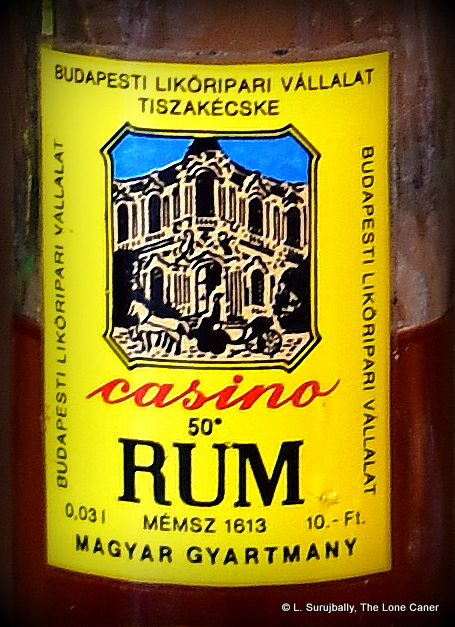
Part of the problem with this “rum” is that the bottle itself doesn’t say who made it (the notations refer to the “Budapest Liquor Industry” and “Product of Hungary”) – after some sleuthing around I tracked it down to a company called Zwack, which is famed in the country for its high-alcohol herbal bitters called Unicum (one of the national drinks of Hungary), and a 60% once-it-was-a-rum-but-no-longer called Portorico, which is widely used for baking (like Stroh). Unfortunately its website doesn’t mention the Casino or have a picture, but since I located a Casino bottle label with Zwack printed on it, that cleared things up.
Figuring out what’s in it was harder, and here I drew a blank. My thinking, however went like this: eastern European countries were famed – or at least renowned – for their inländer (domestic) rums, which were usually ethanol or neutral alcohol that had spices and infusions added to them. Stroh, the Badel Domaci from Croatia and the Tuzemak from Czechoslovakia, and any amount of verschnitts from Germany (Flensburg in particular) followed this pattern, and Zwack itself as a company was noted for its work with alcohols and herbal infusions. So even though I know little about Zwack’s production specifically — and I was told that some inländer producers are now importing bulk rum produced in the Caribbean — I assume they followed this trend of manufacture generally. That said, I can’t say with assurance whether the Casino was made from molasses or beets, though I suspect it’s the latter.
 If we accept these data points, then of course the Casino is not, by all current definitions, a rum, and in point of fact, the entry might just as easily be listed in the Rumaniacs page since this version is no longer being made — the word “rum” was either replaced by “room” or dropped completely from the label when Hungary joined the EU in 2004, and that suggests a manufacture for the product I tasted of around 1988-2003 which actually makes it a heritage rum entry, but what the hell.
If we accept these data points, then of course the Casino is not, by all current definitions, a rum, and in point of fact, the entry might just as easily be listed in the Rumaniacs page since this version is no longer being made — the word “rum” was either replaced by “room” or dropped completely from the label when Hungary joined the EU in 2004, and that suggests a manufacture for the product I tasted of around 1988-2003 which actually makes it a heritage rum entry, but what the hell.
Tasting notes, then…
The nose is firm and distinct – the 50% ABV strength helps there, of course – and quite sweet, almost like a Tokaji. Notes of brown sugar, black tea, and what stays the longest in both nostrils and memory is the sweet notes of gummi bears and lollipops and bubble gum. There’s other more fruity aromas as well – prunes, rip apricots, peaches, in syrup, some orange peel and chocolate with rum in the centre; as it hangs around it gets flowery and perfumed. Quite a lot going on here, but in terms of a rum profile, not really – it’s all additive-derived, not a genuine rum note in sight.
Palate follows the theme of a spice driven rum with a better-than-usual strength: dry, crisp and quite sweet. Candied oranges, icing sugar, ginger, no caramel or molasses notes here. It’s spiced for sure, but reasonably well done, and if tasted blind I’d suggest you might think it was a low-rent mid-ester-level Jamaican without the rubber and salt. The finish is nowhere near to the level of either the nose or the taste – short, dry, harsh, unrelieved by any serious aromas or closing notes over and beyond sweet candies, chocolate oranges and light flowers, plus maybe a hint of cinnamon.
The funny thing is, I quite liked it. Not as a sipping rum – its artificiality is way to evident for that – but as a sweet dessert thing to have with or dribble into an ice cream dunked into a double espresso…oh yeah. It’s fine for that. Unfortunately, not for much else.
(#687)(72/100)
- My thanks to Tamas Gabor and Gergő Muráth who helped me with the background and research sections.
- A hydrometer tested this at 46.77% ABV – that works out to about 15g/L additives
- No information is available on how old the distillate might have been, if it even was aged at all.